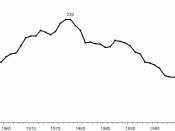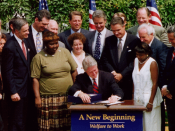Opinions about the last two welfare reformsJulie NessUniversity of PhoenixAxia CollegeApril 20, 2008The Opinions about the Last Two Welfare ReformsThe main opinion throughout society, about the welfare reform of 1996 was that it was supposed to be good for the public, and that it has been nothing but detrimental. By former President Clinton changing the way the welfare program was structured, it was made to look like the reform was a positive move, but in reality, the participants are worse off now than when they were on welfare.
The Federal government provides programs to help low income or no income families. One in particular was Aid to Families with Dependent Children (AFDC), which was changed to Temporary Assistance to Needy Families (TANF) in 1996 by former President Clinton.
Congress passed the Aid to Families with Dependent Children Act in 1935 to help widows stay home and raise their children.
(Etter, 2006) Under the old system, the rules stated a mother could not work and receive welfare, the government considered it as cheating. In 1996, President Clinton enacted The Bipartisan Bill, which ended entitlement welfare, under which low income families could receive welfare with relative ease. Now welfare recipients have a time limit of a five year lifetime assistance for being on welfare, and must show they are actively looking for work, and have to be employed within two years of entering the program. (Etter, 2006) The welfare reform refers to the 1996 Personal Responsibility and Work Opportunities Reconciliation Act (PRWORA) which replaced the Aid to Families with Dependent Children (AFDC), in which the government paid at least half of all benefit costs on an open- ended basis, with the Temporary Assistance to Needy Families (TANF) block grant, in which each state is given a grant based on its previous...


